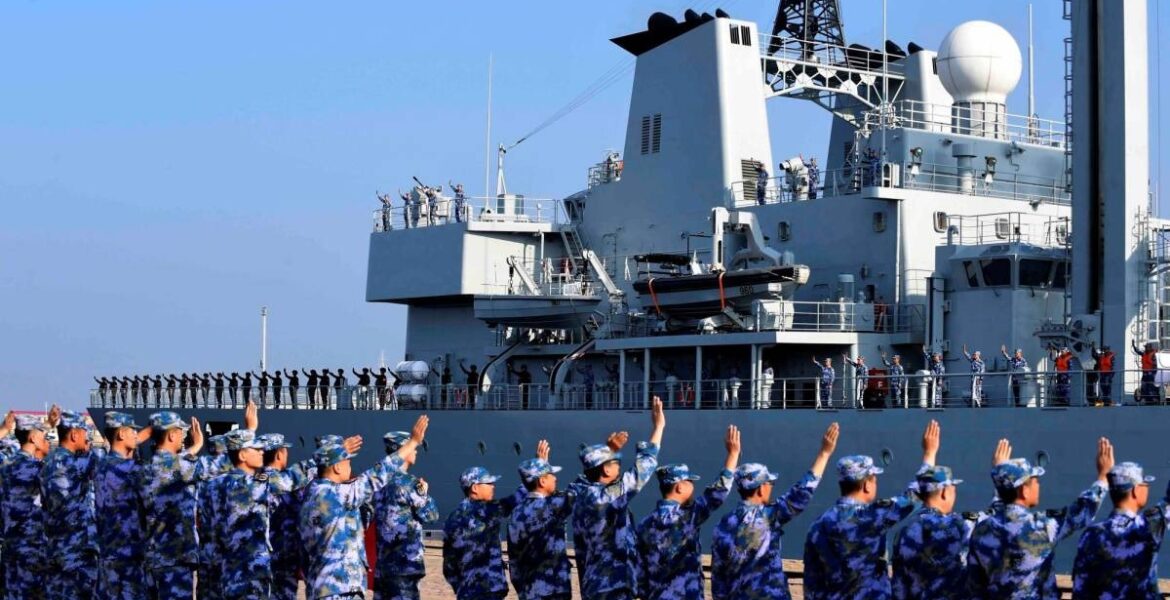China is aggressively pursuing conflict with its Indo-Pacific neighbours, employing the People’s Liberation Army-Navy (PLA-N) as a potent tool to intimidate regional navies. Beijing asserts ownership over the South China Sea (SCS), sparking tensions with smaller neighbouring nations. Unilateral provocations by PLA-N vessels in SCS waters have escalated, exemplified by recent incidents. In one instance, a Chinese warship engaged in “unsafe and unprofessional” behaviour, emitting hazardous sonar pulses toward Australian divers, causing minor injuries.[1] This incident transpired on November 14 within Japan’s Exclusive Economic Zone in the East China Sea (ECS) region.[2] Similarly, Chinese vessels aggressively obstructed a Philippine boat delivering supplies to troops stationed in the disputed Second Thomas Shoal, part of the Spratly Islands, on October 22.[3] As per reports, China’s coast guard intentionally collided with the Filipino boat.[4] Both incidents starkly portray China’s assertive plans in dominating the SCS region. Such actions not only heighten regional tensions but also pose risks to maritime safety and stability, undermining efforts for peaceful resolution of disputes among neighbouring nations.
Responding to the November 14 incident, Australian Prime Minister Anthony Albanese strongly condemned Beijing for the “reckless, unsafe, and unprofessional” actions of its navy in the East China Sea, emphasising the detrimental impact on the recovering relationship between Australia and China.[5] Despite PM Albanese’s recent visit to China, which he hailed as marking “significant progress” in bilateral relations, Beijing’s unilateral escalation through aggressive manoeuvres by the PLA-N against Australian divers persisted.[6] Reports indicate that the Australian frigate HMAS Toowoomba was engaged in a United Nations sanctions enforcement mission off Japan when its props became entangled in a fishing net.[7] In efforts to resolve the issue, the Australian crew dispatched divers to clear the nets, ensuring the ship’s navigation. Prior to the dive, they alerted nearby vessels through VHF radio communication and standard signalling, adhering to safety protocols. However, this incident exemplifies Beijing’s disregard for regional stability, despite diplomatic efforts to foster improved relations.
As the Australian divers carried out their work, the Chinese warship Ningbo (pennant number 139) drew near.[8] The Australian frigate’s crew attempted to caution and inform the Chinese vessel via radio about the presence of divers below.[9] According to the Australian Ministry of Defence statement, the Chinese ship acknowledged the warning but persisted in its approach.[10] Moreover, it was detected that the Chinese vessel was “using its hull-mounted sonar in a manner that endangered the safety of the Australian divers.”[11] The emission of such high-level underwater sound can cause divers to experience dizziness, hearing damage, or other injuries, a fact well-known to the Chinese crew.[12] Therefore, the deliberate action by the PLA-N seemed aimed at intimidating the Australian navy personnel and asserting dominance in the ECS region.
The United States government also condemned the incident. US Assistant Defence Secretary for the Asia-Pacific Ely Ratner said on social media, “This week, dangerous behaviour by a PLA destroyer resulted in the injury of personnel supporting a lawfully operating (an Australian Navy) vessel, the latest example in a pattern of coercive and risky PLA operational behaviour.”[13] Similarly, the Japanese government has shown serious concerns about “any acts that could increase tensions in the region, including this act, and is closely monitoring the situation.”[14] Expectedly, Beijing denied accusations and claimed that its navy destroyer did not carry out any activities that might affect Australian diving operations, and that Canberra’s remarks on the incident were “completely inconsistent with the facts.”[15] It is noteworthy that HMAS Toowoomba was, at the time of the Chinese provocation, “enroute to commence a scheduled port visit.” Moreover, in early November, the Australian frigate had participated in a series of multinational exercises off South Korea’s southeast coast, working to “improve cooperative boarding, anti-submarine and anti-air missions”.[16] Reports indicate that there has been no public indication that the Australian ship had done anything to provoke or otherwise merit harassment from Chinese military forces.[17]
Similarly, the PLA-N consistently harasses Filipino navy vessels, asserting its dominance in the South China Sea (SCS) region.[18] Following the October 22 incident, Manila’s Task Force for the West Philippine Sea condemned China’s actions as “dangerous, irresponsible, and illegal,” a “violation of Philippine sovereignty, sovereign rights, and jurisdiction”.[19] Washington voiced support for Manila, condemning China’s “disruption of a lawful Philippine resupply mission”.[20] In another late October incident, Chinese forces near a disputed shoal in the SCS region trailed a Philippine navy patrol ship.[21] As a result, the Philippine military has demanded that China cease its “dangerous and offensive” actions after a Chinese navy ship shadowed and attempted to obstruct a Philippine navy vessel on a resupply mission. China has encircled the shoal island with navy and coast guard ships, impeding the movement of Filipino navy vessels.
These recurring incidents affirm China’s hegemonic ambitions, aggressively expanding its presence in the Indo-Pacific region’s maritime borders. Beijing’s actions undermine the principles of a free and open Indo-Pacific (FOIP), indicating its persistent disregard for these values.
[1] https://www.theguardian.com/australia-news/2023/nov/18/australian-naval-divers-injured-after-being-subjected-to-chinese-warships-sonar-pulses
[2] https://www.reuters.com/world/australia-pm-says-chinese-navy-incident-that-injured-diver-was-dangerous-2023-11-20/
[3] https://www.aljazeera.com/news/2023/10/23/china-philippines-escalate-rhetoric-in-south-china-sea-collision-row
[4] https://www.france24.com/en/live-news/20230823-chinese-ships-chase-block-philippine-boats-in-disputed-sea
[5] https://www.canberratimes.com.au/story/8429306/chinese-attack-on-navy-ship-divers-dangerous-pm/
[6] https://www.aljazeera.com/news/2023/11/4/australias-albanese-heads-to-china-touting-consistent-steady-engagement
[7] https://maritime-executive.com/article/chinese-warship-slightly-injures-australian-navy-divers-with-its-sonar
[8] https://www.abc.net.au/news/2023-11-18/naval-chinese-warship-injury/103121900
[9] https://www.reuters.com/world/asia-pacific/australia-criticises-china-unsafe-unprofessional-naval-interaction-2023-11-18/
[10] https://edition.cnn.com/2023/11/20/asia/australia-albanese-china-navy-dangerous-conduct-intl-hnk/index.html
[11] https://maritime-executive.com/article/chinese-warship-slightly-injures-australian-navy-divers-with-its-sonar
[12] https://www.intechopen.com/chapters/18878
[13] https://www.afr.com/politics/federal/albanese-evasive-on-china-navy-incident-20231120-p5el8b
[14] https://www.afr.com/world/asia/japan-has-serious-concerns-about-australia-sonar-incident-20231121-p5els7
[15] https://www.1news.co.nz/2023/11/21/chinas-denial-of-australian-warship-attack-regrettable/
[16] https://www.forbes.com/sites/craighooper/2023/11/18/chinese-navy-sonar-blasts-aussie-sailors-fallout-threatens-australias-pro-china-government/?sh=6c0f62c26016
[17] https://www.stripes.com/theaters/asia_pacific/2023-11-02/south-korea-australia-air-sea-exercise-11914862.html
[18] https://www.bbc.co.uk/news/world-asia-pacific-13748349
[19] https://www.bbc.com/news/world-asia-67185930
[20] https://www.voanews.com/a/philippines-says-ships-bumped-by-chinese-vessels-near-disputed-shoal-/7321239.html
[21] https://apnews.com/article/philippines-scarborough-shoal-south-china-sea-disputes-8bd563cd4eeace571e3ef32174c3fbe3
Xi Lao is a freelance journalist based in Taiwan.


